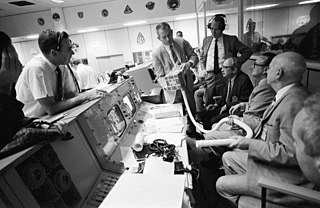Related Research Articles

The American Institute of Aeronautics and Astronautics (AIAA) is a professional society for the field of aerospace engineering. The AIAA is the U.S. representative on the International Astronautical Federation and the International Council of the Aeronautical Sciences. In 2015, it had more than 30,000 members among aerospace professionals worldwide.
Jan Roskam was the Deane E. Ackers Distinguished Professor of Aerospace Engineering at the University of Kansas. He is the author of eleven books on airplane design and flight dynamics and over 160 papers on the topics of aircraft aerodynamics, performance, design and flight controls. He founded the company DARcorporation with Willem Anemaat.
Dr. John S. Langford is the Founder and CEO of Electra.aero, a startup developing hybrid electric aircraft for regional mobility. He was previously Founder, President, and C.E.O. of Aurora Flight Sciences. Langford founded Aurora Flight Sciences in 1989 in order to design and manufacture high altitude UAVs that could be used for global climate change research. In 2004, Langford received Virginia’s Outstanding Industrialist award for his contribution to business development in Virginia.

Aerospace engineering is the primary field of engineering concerned with the development of aircraft and spacecraft. It has two major and overlapping branches: aeronautical engineering and astronautical engineering. Avionics engineering is similar, but deals with the electronics side of aerospace engineering.

A human-powered aircraft (HPA) is an aircraft belonging to the class of vehicles known as human-powered transport.

Tom D. Walshaw (1912–1998) was an engineer, author and contributor to the British magazines Model Engineer and Engineering in Miniature. Many of his magazine contributions and books were authored under the pseudonym Tubal Cain. The pseudonym relates to the Tubal-cain, the biblical metal worker. As Tubal Cain he made over 424 contributions to Model Engineer, beginning in 1971. These were mainly divided between workshop equipment articles and model stationary engine constructional articles. He graduated in mechanical engineering at Loughborough University in 1934. and eventually, after a career in mechanical design, went back to that university in 1943, becoming, after some years, senior lecturer in mechanical engineering. He went on in 1948 to teach at University of Liverpool. In 1952 he was appointed Head of Department of Mechanical, Civil and Electrical Engineering at Darlington College of Technology. His final academic post was Head of Mechanical, Production and Civil Engineering at Lancashire Polytechnic. He gained the first of his many model engineering exhibition awards in 1949. At one point he was editor of the Transactions of the Newcomen Society. Walshaw died on 2 May 1998.
John H. McMasters was an aeronautical engineer notable for his contributions to aerodynamics and engineering education.
The Chrysalis was a human-powered biplane, designed and built by graduates and undergraduates of the Massachusetts Institute of Technology, with Professor Eugene Larabee acting as Project Adviser. MIT had previously built two HPAs, the BURD and BURD II, both of which were unsuccessful.
The Southend MPG Mayfly was a British two-seat human-powered aircraft built by members of the Southend Man-Powered Group in the 1960s. It was one of the first two-person human-powered aircraft to have been built and tested, although it never flew.
The Paxton man-powered aircraft was the project of architect Tony Paxton, to create a compact human-powered aircraft, suitable for sports flying.
The Micron was the second of two human-powered aircraft designed and built by Peter Wright, an engineer from Melton Mowbray, England.
The Wright MPA Mk 1 was the first of two human-powered aircraft designed and built by Peter Wright, an engineer from Melton Mowbray, England.
The Olympian ZB-1 was the first human-powered aircraft to have flown in the United States. It was designed, built, and flown by Joseph A. Zinno, of North Providence, Rhode Island. Zinno had previously been a USAF Lieutenant Colonel, and undertook the challenge of making a human-powered aircraft as a post-retirement project.
The BURD II was a two-place human-powered biplane, designed and built by graduates and undergraduates of the Massachusetts Institute of Technology. It is very similar to the original BURD, which suffered a structural collapse during testing in 1975, but incorporated changes to its structure and its control systems.
The Monarch A was a human-powered aircraft, designed and built by graduates and undergraduates of the Massachusetts Institute of Technology, with Professors Walter Hollister and Ed Crawley acting as Project Advisers. Professor Eugene Larrabee, who had been the adviser for the 1979 MIT Chrysalis HPA, also provided support.
The Dragonfly was a human-powered aircraft, designed and built by the Prestwick Man Powered Aircraft Group, based at the Prestwick International Airport in South Ayrshire, Scotland.
The Reluctant Phoenix is a British human-powered aircraft, designed and built in the 1960s by the British engineer Daniel Perkins. It was notable for being an inflatable delta-wing tailless design, and for being flown indoors.
The Smolkowski-Laviolette biplane was a Canadian human-powered biplane designed and built by two Calgary aeronautical engineers, Alvin Smolkowski and Maurice Laviolette, in the 1960s.
Ronald Godfrey Moulton was an English author and editor, notable for his work in the field of scale models and aeromodelling.
References
- 1 2 3 — (1971). Man-powered flight. Hemel Hempstead, England: Model & Allied Publications Ltd. p. back cover. ISBN 9780853440468.
- ↑ — (April 1972). "Man-Powered Flight as a Sporting Activity". AIAA Student Journal. Vol. 10, no. 2. New York, NY: American Institute of Aeronautics and Astronautics. p. 27. Retrieved 14 May 2023.
- 1 2 3 — (2007). Pedal powered planes. Matlock, Derbyshire: Scarfin Books. pp. 121–142. ISBN 9781900446105.
- ↑ Palmer, R.S.J. & — (March 1986). "Man-powered flight in South-East Asia". Aerospace. London, UK: Royal Aeronautical Society. pp. nk. ISSN 2052-451X.